Returnal Beginner's Guide: Essential Tips & Tricks To Know Before Playing
Here are some handy tips that'll help beginners and even advanced players.
Returnal is PS5's new exclusive arcade shooter from the genre's experts at Housemarque. At first glance, it might seem like a familiar experience at first. With its rougelite structure, creepy atmosphere, and fast-paced third-person action, it's easy to think of comparisons and mashups of existing titles like Hades, Metroid, and Control. Like most rouguelites too, Returnal's fun is found in growing your skills through failure, with each run steadily teaching you how to best approach the game. It can help to go in with a little guidance, especially if you're finding the opening hours particularly challenging. Here are some tips that will help explain some of Returnal's more obscure mechanics and speed up your pace, whether you're just starting or have sunk in several hours already.
Don't Stop Moving
Housemarque is departing from its traditional 2D arcade shooter roots with Returnal, but that doesn't mean it hasn't brought with it the same fundamental gameplay pillars. One of those is the bombardment of projectiles and enemies you'll have to deal with, making any time you remain stationary progressively more dangerous. Returnal's combat arenas are designed to feel cramped purposefully, but each one offers nooks and crannies for you to exploit, allowing you to create space and distance from foes. Better yet, consistently moving around forces enemies to break formation and find different ways to get to you, creating better chances for you to pick them off individually.
Firearms Expert Reacts to Ghost Recon Breakpoint's Guns Xbox Studio Closures Are Confusing | Spot On Gray Zone Warfare | Community Briefing Trailer #1 Senua's Saga: Hellblade II - Senua's Psychosis Feature Trailer Squirrel With A Gun - Official Announcement Gameplay Trailer Night Slashers: Remake || Official Christopher Smith Character Gameplay Trailer 15 MORE Things You STILL Didn't Know In Zelda Tears Of The Kingdom Street Fighter 6 - 8 Minutes of Akuma Gameplay (High-Level CPU) Animal Well GameSpot Review Roblox - Netflix Nextworld Official Trailer Crow Country | Official Launch Trailer Master Detective Archives: RAIN CODE Plus - Official Announcement Trailer
Please enter your date of birth to view this video
By clicking 'enter', you agree to GameSpot's
Terms of Use and Privacy Policy
As your arsenal of gadgets grows, your ability to move around a space expands, too. The grappling hook (which you only unlock a few hours in) is a great example of this, letting you string together life-saving swings and dexterous dodges to get out of even the hairiest of situations. But when push comes to shove, making sure you're comfortable with the ridiculous speed of Selene's sprint will go a long way toward ensuring your survival. As long as you're moving as much as you're shooting, you'll be fine.
Aiming Down Sights Has Benefits
With a focus on movement, it might seem redundant for Returnal even to include an option to aim down the sights of your weapon. It slows you down and forces you to be precise, at the expense of a narrower field of view that could mean missing some incoming projectiles. It's tempting then to just never use ADS and rely on the accuracy of hit-fire, but you'll then be missing out on exploiting weak spots on enemies.
This is especially important for both boss-like enemies, each of which generally features a weak point that can only be seen when aiming down the sights. It also helps you focus your fire on these points, which can be crucial for both slow-firing weapons and ones with small magazine sizes. It's also the easiest way to stagger these brutes, giving you a chance to do critical damage while also not being shot at. Making sure every bullet finds its mark can bring down these massive targets much faster than if you just decide to fire from the hip, which means less time for them to potentially take away chunks of your health.
ADS And Alt-Fire Are The Same Button, But You Can Change It
One of Returnal's best attributes is how it makes use of the unique features afforded by the DualSense controller. One of the most prevalent is its use of L2, which acts as a means to both aim down sights and engage each weapon's alternate fire mode. A half-press, aided by the controller's resistive triggers, puts you in ADS, while pulling fully down gets you into alt-fire mode. It will take a couple of runs to get used to, but quickly becomes second nature.
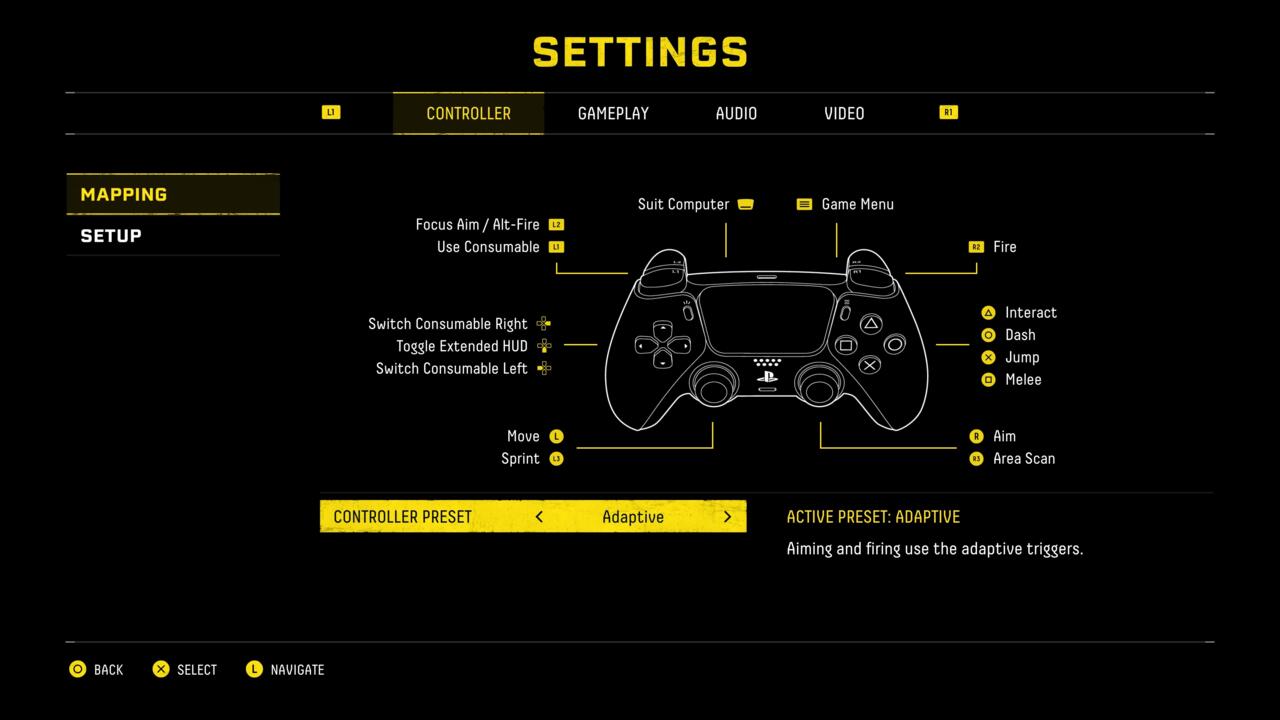
Still, if you're just not finding a groove with the setup and keep wasting your alt-fire when all you wanted to do was aim, Returnal does offer a more traditional controller setup that reserves L2 just for aiming and maps your alt-fire to L1 instead. You can activate this in the settings menu at any time, so experiment with both and see which feels more comfortable.
Pay Attention To Your Active Reload
Like Gears of War, Returnal features an active reload system that can help you reload your weapons faster with the right timing. Each weapon (and each variation of each weapon) features its own timing and active reload window, which can be a bit confusing to get into a rhythm with at first. But your perseverance will be rewarded, as in a chaotic fight, the difference between life and death can be the second or two wasted on a mistimed or missed active reload, especially with weapons that need to be reloaded after every shot. Focus on the bar in your crosshair and adjust to the dynamic timing window with every new weapon you pick up; you'll be rewarded for it.
High Tier Weapons Aren't Always The Best Choice
Weapons you find in Returnal are governed by weapon proficiency--a bar you gradually fill up during each run that determines the tier of weapons you'll find. It might be tempting to just focus on the overall weapon level and swap for anything higher than what you have, but as runs start becoming longer and enemies introduce more complex attack patterns, having a weapon that you're comfortable with is often more deadly than one with a higher level.
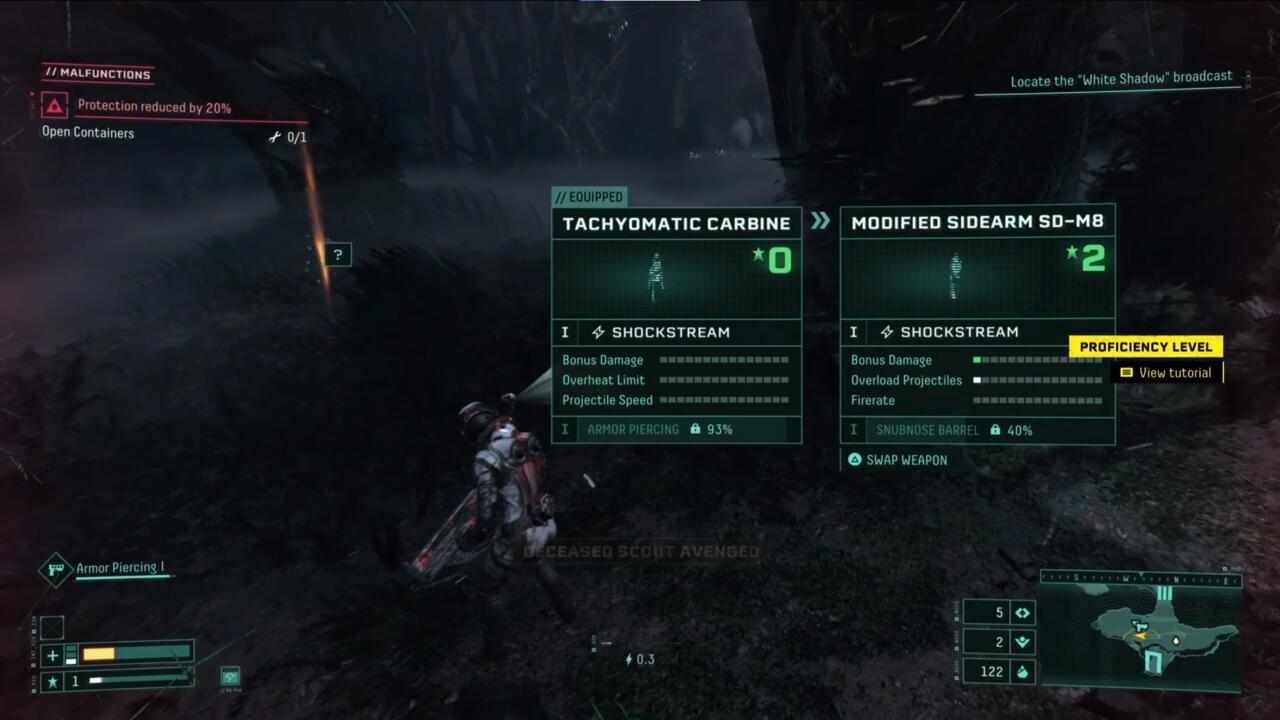
On top of that, the weapon level doesn't consider the alt-fire and perks for your equipped weapon, which should give you pause every time you consider switching up. Returnal's second biome, for example, is filled with mostly airborne enemies, making longer-range weapons a bit easier to work with in its opening stages. Make no mistake, adapting to new weapons and choosing the right one for the part of a run you find yourself in is crucial. But if you're still blowing enemies away and feel like you've gotten into a groove, stick with what you have until you absolutely feel like it's not strong enough anymore.
Dash Into Danger, Not Away From It
One of the skills you start with is an incredibly useful dash that you can pull off pretty much anywhere, but unlike many action games, Returnal expects you to use it to go towards projectiles, not necessarily away from them. While dashing, you are invincible to attacks, letting you use it to bypass a wall of projectiles while also closing the gap to an enemy for a devastating melee kill. Your dodge is also used for some light puzzle-solving, as many optional rooms will be brimming with lasers and other hazards that you will need to deftly dodge through to escape.
Things change later in the run where certain attacks (denoted by their purple color) will not allow you to dash through them safely. This can be slightly jarring after hours of muscle memory telling you that it's totally doable but just be warned of the sudden shift.
Don't Forget Your Powerful Melee
Speaking of melee, once you've managed to get far enough into Returnal's first biome, you'll be rewarded with a permanent melee attack, which you should incorporate into your attacks as much as you can. Not only does it just look phenomenal when you slice up an enemy just right, but your melee is consistently one of the most powerful attacks in the game. Most enemies (outside of bosses) will die with one slash if at half or less health. As you pump up your adrenaline level, your melee will become even more powerful, letting you clear who groups of enemies at a time.
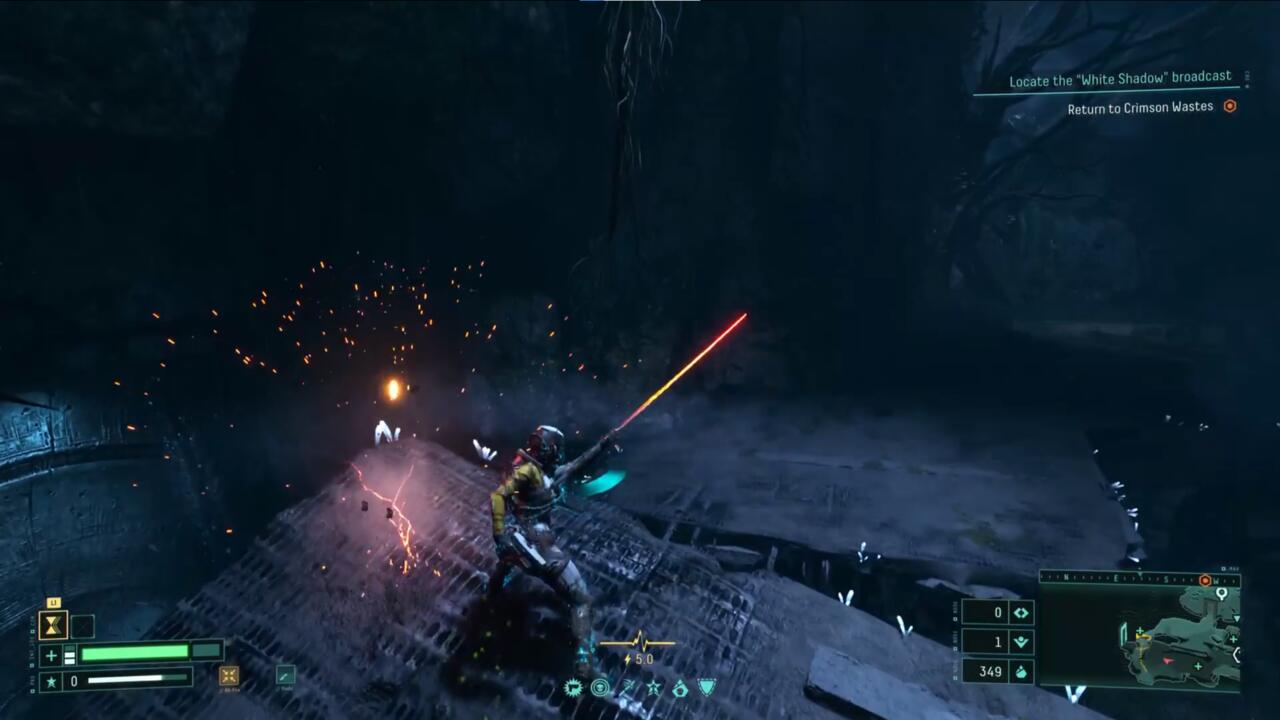
It can be easy to forget about it when you're more preoccupied with returning projectiles at enemies, but ignoring melee will make Returnal's action harder to cope with as it becomes more frantic. Enemies with shields also require a melee hit before you can do any other damage to them, so it's advisable to become comfortable with getting up close and personal with them before you find a run prematurely ended because of it.
Avoid Damage As Much As Possible
This might seem like a no-brainer for a shooter. Getting hit less means less death, so of course, you're going to avoid it. Thing is, shooters make us accustomed to taking some hits to deal out a few, often with systems that lean toward rewarding you even if you're careless. Returnal isn't like that at all, and that's evident in its Adrenaline mechanic.
Your adrenaline multiplier increases with every few enemies you kill without taking damage, going up to a maximum level of five. Each level comes with its own perks, such as the ability to detect enemies through walls, a more powerful melee attack (when you unlock it), and even more currency rewards on kills. Take damage, however, and that gets reset down to zero. The benefits of a high adrenaline meter alone are enough to make it advisable to prolong a fight rather than take an unnecessary risk, but that only grows when you start finding suit upgrades that synergize with adrenaline (such as one that heals you based on your current adrenaline level).
Always Search For Health And Resin
One mechanic Returnal doesn't immediately make clear is the intrinsic link between health pickups and your ability to increase your total health pool. Health pickups differ between resin and vials--the former contributes to a bar aside your health that, when filled, will increase your total slightly, while the latter simply heals any missing health. What isn't explained is that if you're at full health, all vials on the map act like resin, meaning they contribute to growing your health total too.
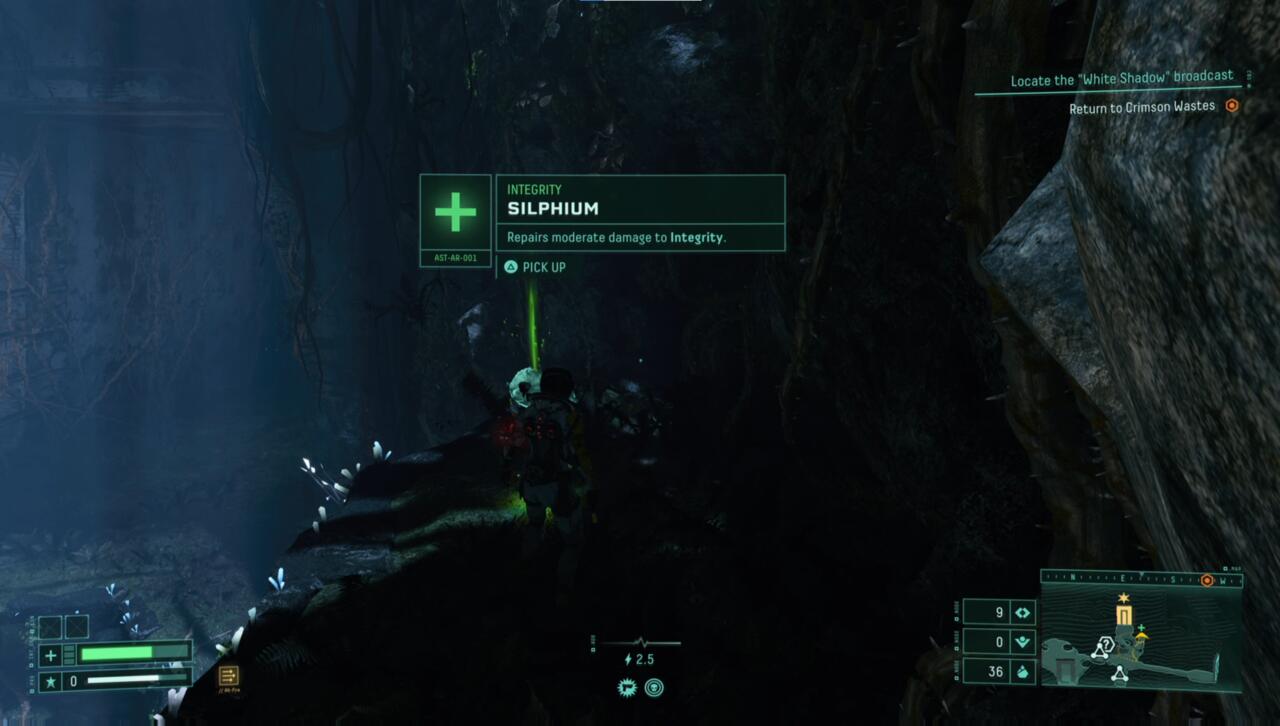
There is a decision you need to make here, though. You can sprint through new combat arena's trying to gather all these pickups before potentially taking damage to enemies, but that also leaves you with nothing to heal up with after a battle. Conversely, you can ignore them until after a fight, but you could find yourself getting later and later into a run without an adequate health total to draw from. Either way, it's good to remember not to ignore these pickups entirely, even if you are fully topped up.
Don't Use Items Immediately As You Find Them
On that note, though, don't feel compelled to make these decisions as they are presented to you, which goes double for any items, fabrication stations, and more you find in each biome. Returnal has each of its biomes littered with fast travel points, encouraging you to go back to areas you might have left items in to reap their rewards later. For example, stone beds that heal you can be activated just before you level for another biome, or consumables you had no space for can still be picked up well after you've left the room you found them in.
Returnal's great map makes it easy to recall where points of interest are, so don't get too caught up in forward progression, and instead, take a moment to take stock, backtrack a little, and ensure you have everything possible before moving on. Especially since enemies don't respawn, making it a risk-free endeavor that can drastically change your run for the better.
Skipping Biomes Is Totally Viable
Once you unlock a new biome, it can be deflating to die early on into it and be greeted with the sting of restarting your run. The good news is that, once unlocked, the path to a new biome is usually presented early into a new run, letting you skip right to it. Each biome also features a weapon proficiency upgrade at the start to bring you right up to what is required for the enemies ahead of you, but you'll still need to find a weapon on that level to be fully up to speed.
Firearms Expert Reacts to Ghost Recon Breakpoint's Guns Xbox Studio Closures Are Confusing | Spot On Gray Zone Warfare | Community Briefing Trailer #1 Senua's Saga: Hellblade II - Senua's Psychosis Feature Trailer Squirrel With A Gun - Official Announcement Gameplay Trailer Night Slashers: Remake || Official Christopher Smith Character Gameplay Trailer 15 MORE Things You STILL Didn't Know In Zelda Tears Of The Kingdom Street Fighter 6 - 8 Minutes of Akuma Gameplay (High-Level CPU) Animal Well GameSpot Review Roblox - Netflix Nextworld Official Trailer Crow Country | Official Launch Trailer Master Detective Archives: RAIN CODE Plus - Official Announcement Trailer
Please enter your date of birth to view this video
By clicking 'enter', you agree to GameSpot's
Terms of Use and Privacy Policy
Worth noting also is the fact that once you defeat a boss in a biome, you're pretty much done fighting it forever, unless you want to return to that battle. So don't worry about having to power through a bunch of tough boss fights after every single death--it's one and done with those.
That Said, Farming Is Important Too
So, while it might be tempting to immediately jump back to where you died, the reality is that you're making things more difficult for yourself that way. Each death resets you basically back to zero, with only your total inventory slots for consumables staying intact. That means suit upgrades, total health, parasites, and more all get reset, which can make instant jumps to more challenging biomes a daunting prospect. There's value in getting familiar with the starting biome and using your refined skills to upgrade as much as possible without taking damage, and only then jumping back to where you last died. Better still, as mentioned, you don't need to fight each biome's boss again, but learning how to dispatch them quickly comes with its own rewards, too. Specifically, bosses drop a health dose of Ether, so if you're light on this essential resource, you might want to try a do-over with a boss you already know how to handle.
Skip Most Malignancies
You'll run across a lot of items in your travels that are glowing purple with "Malignancy." Whenever you pick up one of these items, you run the risk of incurring a malfunction in your suit. Malfunctions come in various flavors, and you can get rid of them by completing certain objectives, like using an Atropian Key, killing enemies with melee attacks, picking up Obolites, and so on. But often, the requirements to clear a malfunction can take a long time to accomplish, and the malfunctions themselves can be fairly damaging--like when they limit your capacity to repair your suit or cut down on your weapon damage.
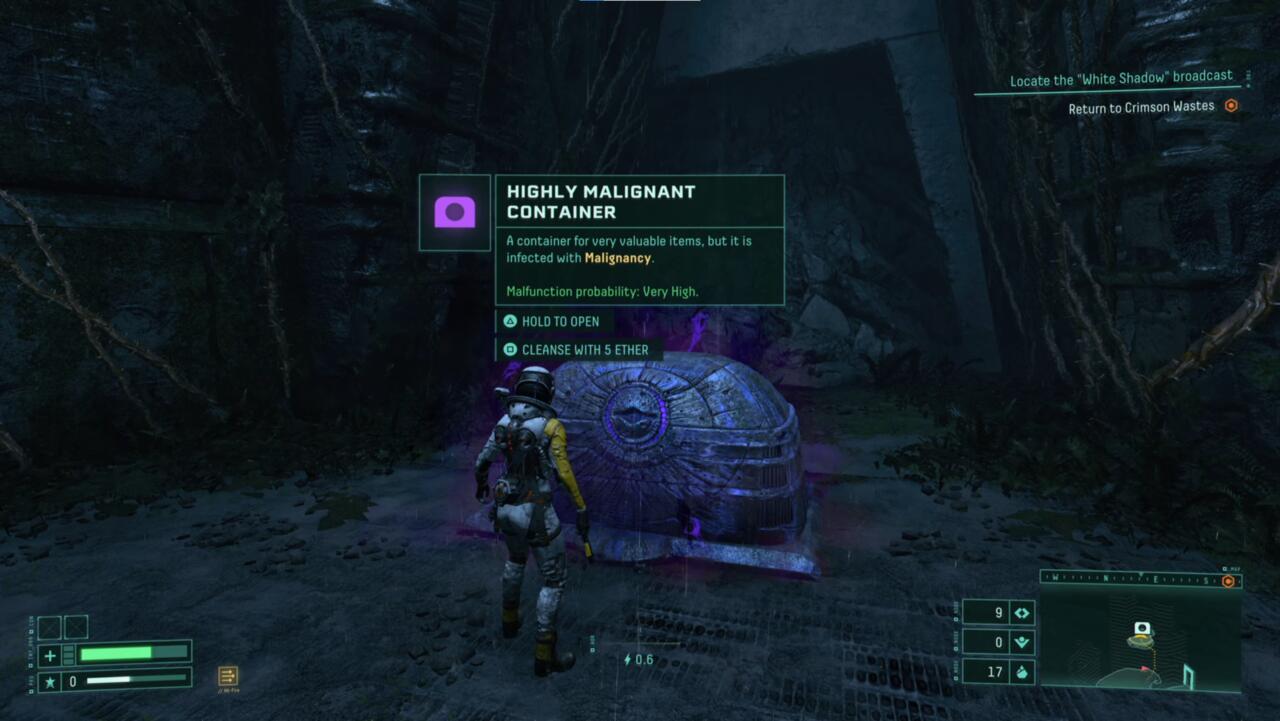
While Returnal wants you to make decisions about whether it's worth the risk of malfunction to gain certain advantages, more often than not, you should ignore malignant items. The malfunctions you get can seriously damage your ability to advance through Returnal's biomes, and the benefits are tough to anticipate or measure. What's more, spending Ether to clear malignancy usually isn't worth it since the contents of every malignant chest are random. You'll often find enough guns, resin, and health pickups without having to resort to using malignant ones--so unless you're desperate to heal yourself in a pinch or find a new weapon, skip malignant pickups to protect yourself.
There's one exception to this rule: malignant keys. They're usually worth snagging if you don't otherwise have any, even if you'll incur a malfunction getting them. It's usually better to have a key on-hand than not, so even if you pass one by, make a mental note of its location so you can return to it if you need it.
Listen (and ADS) For Switches
In general, it's recommended you play Returnal with headphones. The game makes use of the PS5's 3D audio capabilities in some delightfully creepy ways, but there are practical applications as well. The 3D audio can help you identify where enemies are and where bullets are coming from. It can also help you hunt down the switches for barriers.
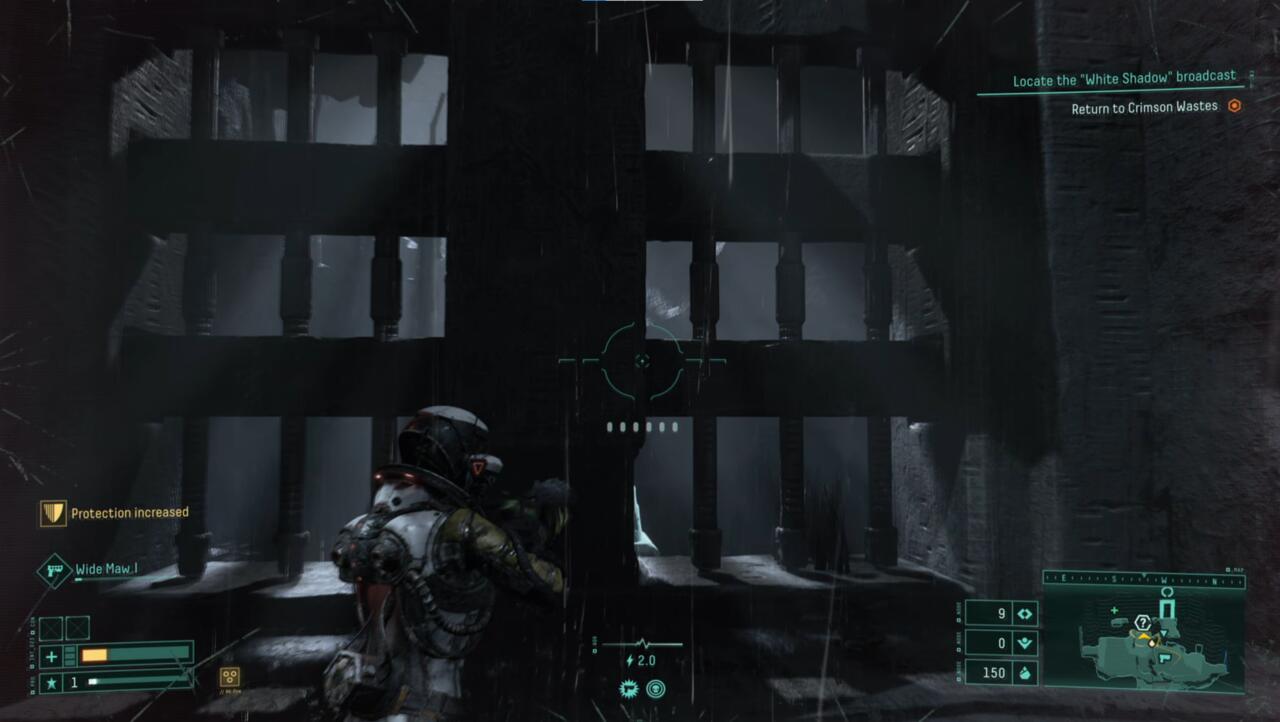
You'll find these early in the game--gray stone barriers you can see through and which always hide items but which you can't pass through or unlock with Atropian Keys. These barriers can be cleared by finding and shooting yellow switches that are hidden somewhere in the room, and as you go on through Returnal, their hiding places will get more clever.
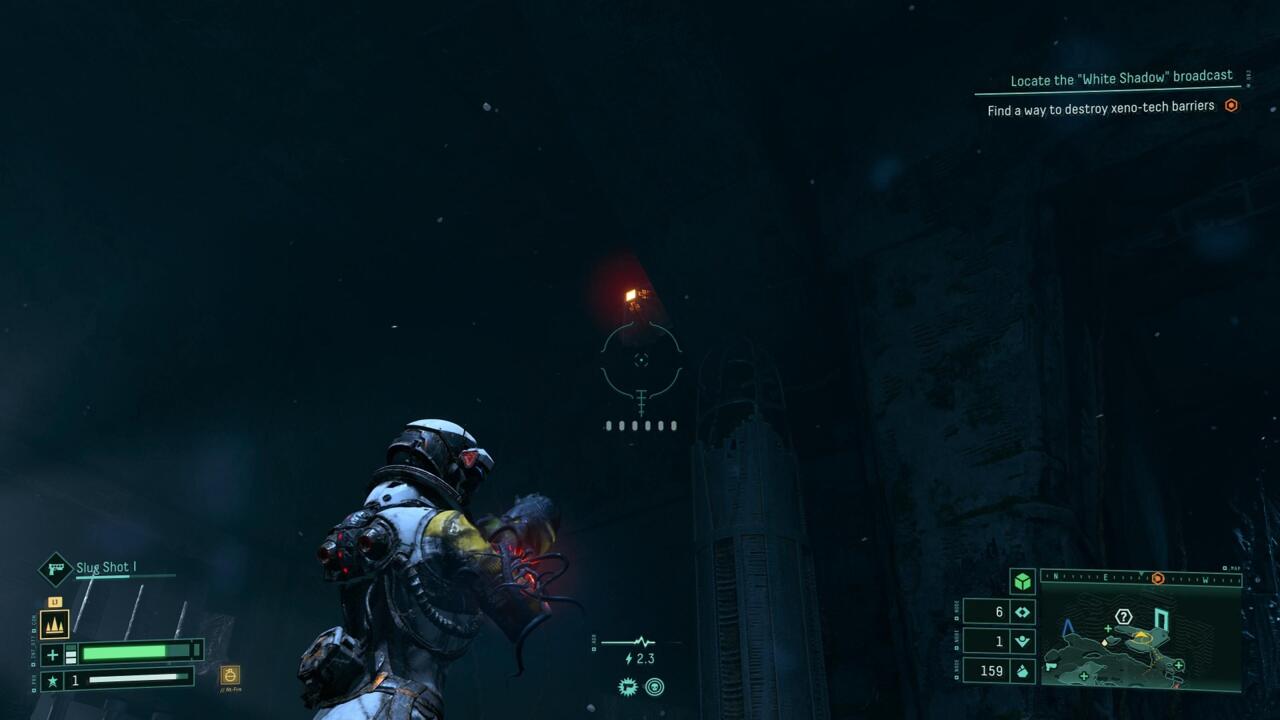
You get some clues to find them, though, if you aim down the sights with your gun. Do that, and the switch will blink red and start emitting a pulsating tone, even if you're not actually looking at it or aiming at it; the switch just reacts to the fact that you're aiming your gun. Use the 3D audio in your headphones to track the switch down while aiming to get your goodies.
Keep An Eye On Your Map
Your most useful tool in Returnal, apart from your gun, is your mini-map. This thing is constantly scanning the environment as you're moving through it and marking points of interest. It also keeps track of enemies, often before you've seen or engaged them. The map gives you a top-down look at your surroundings and rotates along with you depending on the way you're facing, but it provides more context. Essentially, the map can show you what's behind you, and that's huge.
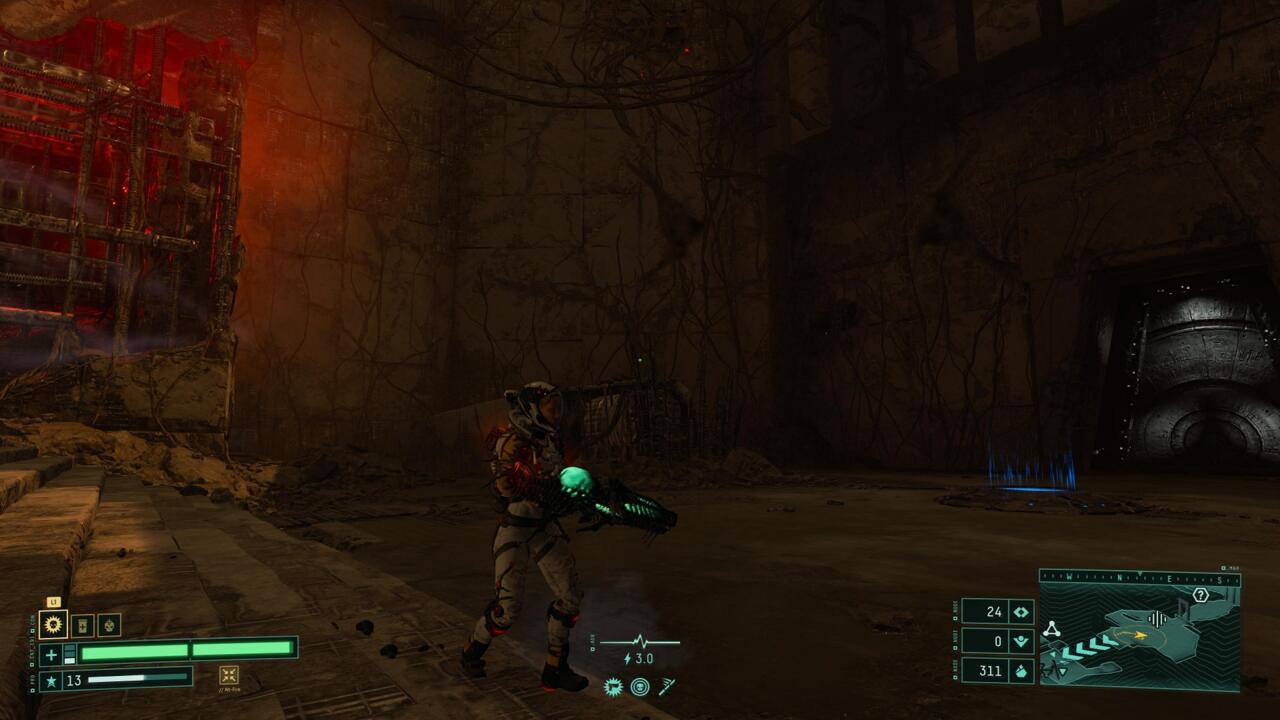
While the bullet-hell nature of Returnal means you'll need to keep your eyes open to avoid attacks, you'll find that a lot of the damage you sustain throughout the game comes from sources you can't see. A huge trick to staying alive is repositioning yourself quickly and efficiently so that enemies are not flanking you, but you can also avoid this by glancing at your map and assessing enemy locations, marked in red. You can use the map to pinpoint where enemies are moving to so you can lose them, find out where they're lying in wait for an ambush, and when they're compromising your cover so you can get the hell out of there. It's an essential tool, especially in big fights.
One last note about the mini-map: It marks everything, so use it to effectively clean out rooms. Guns, Obolites, and health pickups have their own identifiers, but everything else, including parasites, artifacts, consumables, lore pickups, and Ether, are all marked with a triangle pointing down. Seek those things out and make sure you're taking everything with you when you clear out a room.
Don't Be Afraid To Run
Returnal is a tough game. It's a bullet-hell shooter, which means the focus in battles is avoiding lots of incoming enemy fire and reacting quickly to various attacks. But since it's played from a third-person perspective, you lose the benefit of seeing everything on screen at once--enemies can get behind you, bullets can come from places you aren't seeing at the moment, and arenas have twists and pathways that can provide monsters new ways to attack you, as well as ways for you to escape.
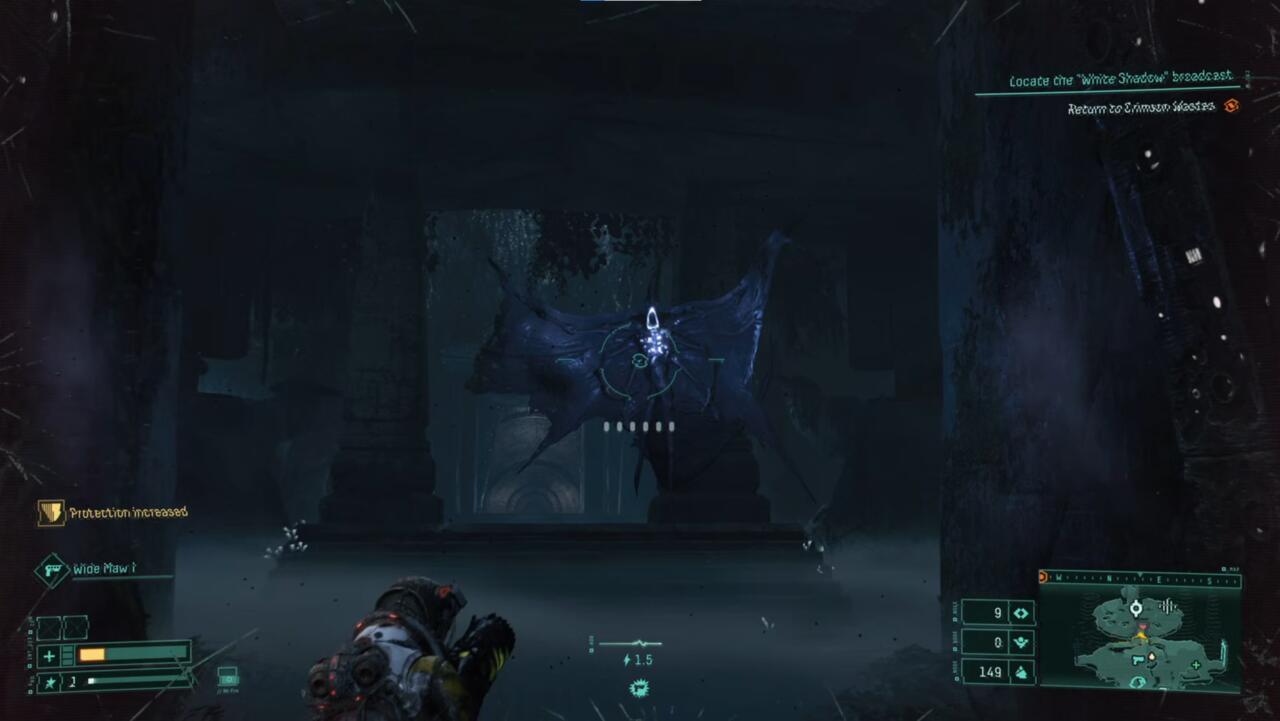
One big tip is that you can run for it in most cases, and if you're getting overwhelmed, you should. Some rooms will go into lockdown when you enter them, forcing you to fight the battle the battle to escape (although usually the lockdown lifts when you kill one big, tough enemy, rather than wipe out all the baddies in the room--so focus on whatever spawns last and you'll usually unlock your exit). But the vast majority will let you enter and exit even in the middle of combat, giving you a chance to get away, reassess, and restart an engagement to your liking. You can also use doors to block enemies and kill them in smaller groups if they're overwhelming you. Enemies can't open doors, so if you pass through one and back away, it'll close, creating a wall between you and your opponents. Some attacks can penetrate doors, so you should still be careful, but you'll be safe from most if you need a breather.
Critically, enemies will not respawnin rooms you've already cleared, so you can always feel good about backtracking to pick up items you passed on or to check side paths. And that means that if you're hitting a wall in one fight, you can often just bail on it and try again later. Don't be afraid to cheese enemies using doors or disengage a battle that's going poorly. Staying alive is your biggest mandate most of the time in Returnal.
Shoot Statues With Yellow Eyes For Obolites
There are tons of statues in Returnal scattered throughout the various biomes, and generally, you want to avoid shooting them. Sometimes they'll spawn those ethereal, ghost-looking enemies that fly through the air if you destroy them; they're also bad cover, crumbling without much punishment.
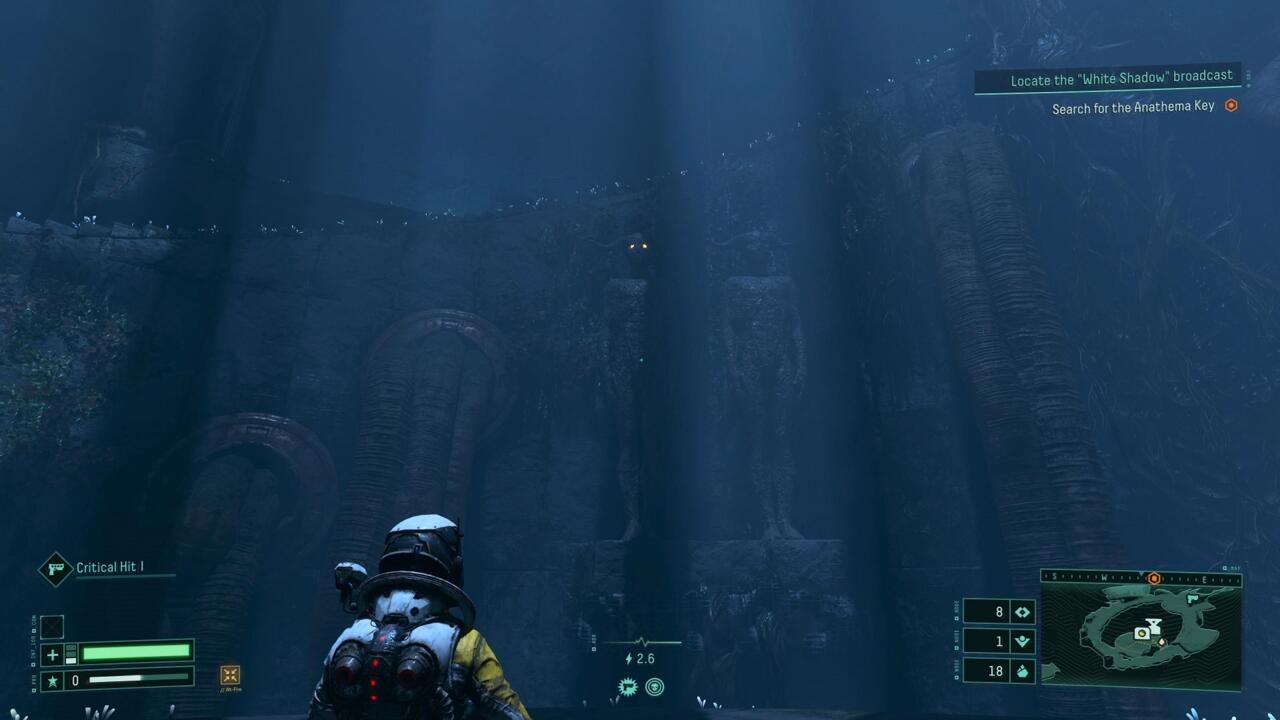
Occasionally, though, you'll spot statues with yellow eyes. Blast these whenever you can, because they're packed with Obolites. The yield is usually pretty low--like 15 Obolites per statue--but it adds up in a hurry when you want to buy expensive upgrades and artifacts. In general, it's a good idea never to let Obolites pass you by if they're not malignant, so keep your eyes open when passing Atropian statues.
Cut Through Purple Plants And Green Eggs
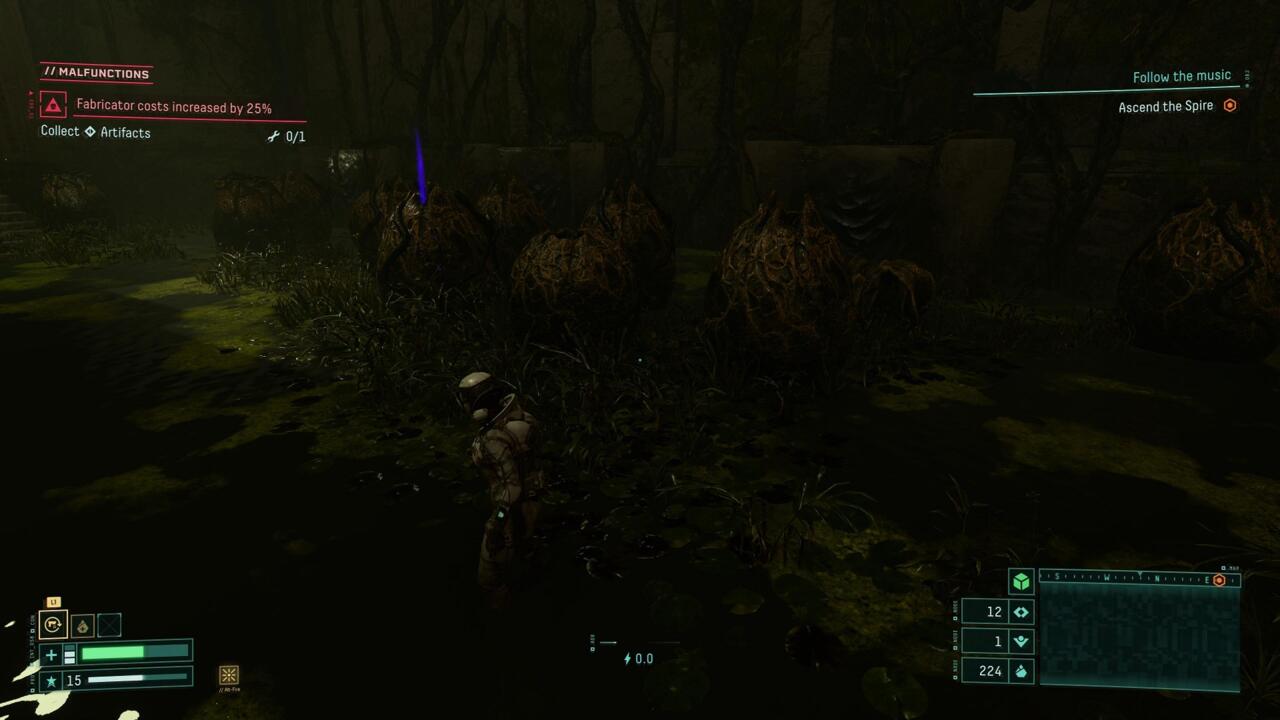
Speaking of things you should destroy--if you see any strange egg-shaped green plants or bulbous purple flower-things, wreck them. In fact, a good rule of thumb is that if you can destroy a plant, you should. These plants, in particular, found in the first and fourth biomes, often hide upgrades and parasites. The drop rate is low, so you'll likely slice up a lot of plants and only find a few things in the biome, but getting extra Silphium Resin or a handy new parasite makes the effort of clearing these things from the edges of every room worth it.
Always Keep An Atropian Key If You Can
Locked doors in Returnal, in particular, are worth exploring. These side paths will sometimes just take you on non-critical jaunts through a biome, but more often, they'll hide nice upgrade rooms that might drop you fresh consumables, artifacts, health upgrades, or Obolites--and sometimes all of them. It can be tempting to use Atropian Keys on locked chests, and these also often yield good rewards, but for my money, it's better to open locked doors. The chances of some high-quality reward generally seem higher, and locked rooms can potentially give you several rewards, rather than just one from a chest. Stockpile keys, even malignant ones, because they're usually worth the hassle. (There's also at least one locked room in a later biome that hides a permanent suit upgrade, but you can't get it unless you had the foresight to bring a key with you.)
Snag The Blade Balancer Artifact To Open Yellow Force Fields
After clearing the first biome in Returnal, you'll gain the Atropian Blade, which allows you to cut through enemy shields and orange-tinted force fields. You'll soon discover yellow force fields that block the paths to some side rooms, however, which your sword can't penetrate. At first, you might think you'll need a new permanent item, like the sword and the grapple, to be able to get through these force fields, but they can actually be knocked down with the sword you already have. You do need one added upgrade, though, and you can only keep it through a single run: the Blade Balancer.
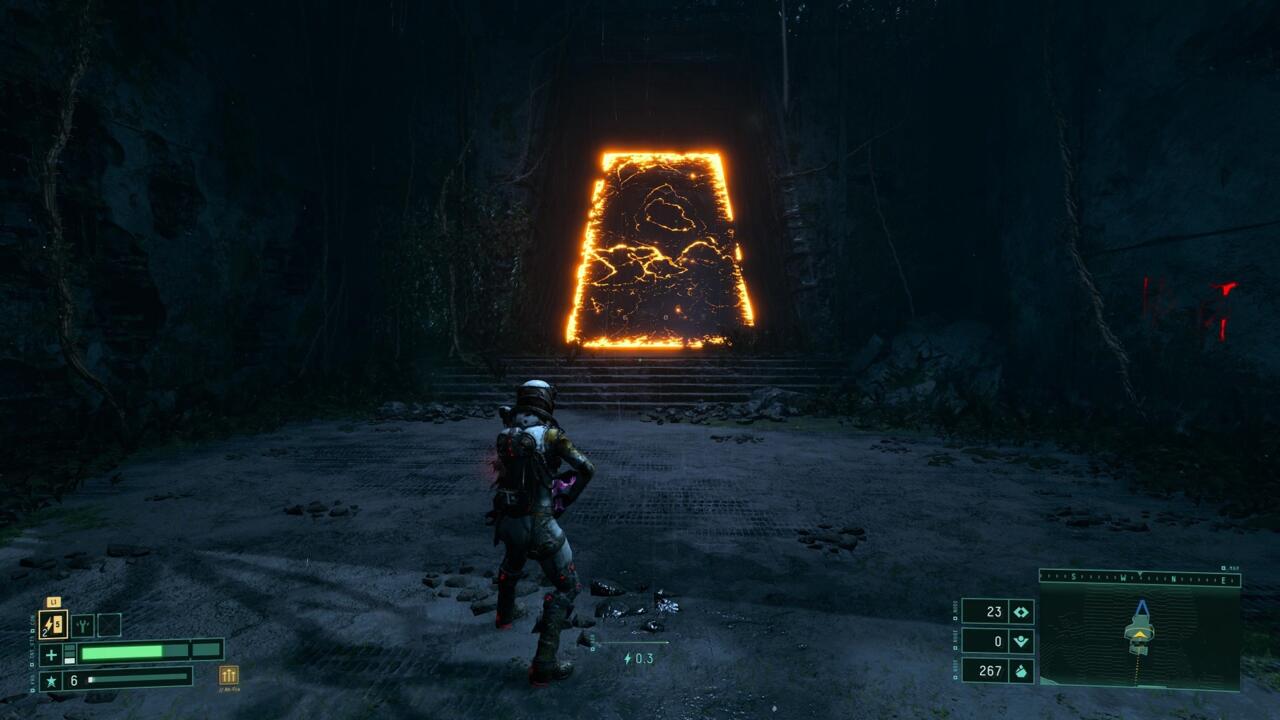
Look for this artifact at fabricators--it often appears at the big fabricator near the boss room of a given biome. The artifact increases your melee damage in general, but once you've installed it, you can break yellow force fields, which almost always block the way to some great items and artifacts. That means the Blade Balancer is almost always worth purchasing. You're likely to find yellow force fields sometime in your run, and even if you don't, the added melee damage can be a life-saver against tougher enemies that chase you around the battlefield.
Keep Six Ether At All Times For Reconstructors
One of the best investments you can make in any biome is the Reconstructor, the big round device with an imprint of an alien set into it. When you find one, fork over six Ether to power it, and especially if you're in a new biome or one you're struggling with. Essentially, it acts as a checkpoint during your run through that biome--if you die, you'll restart at the Reconstructor. The chance at a restart makes the investment totally worth it.
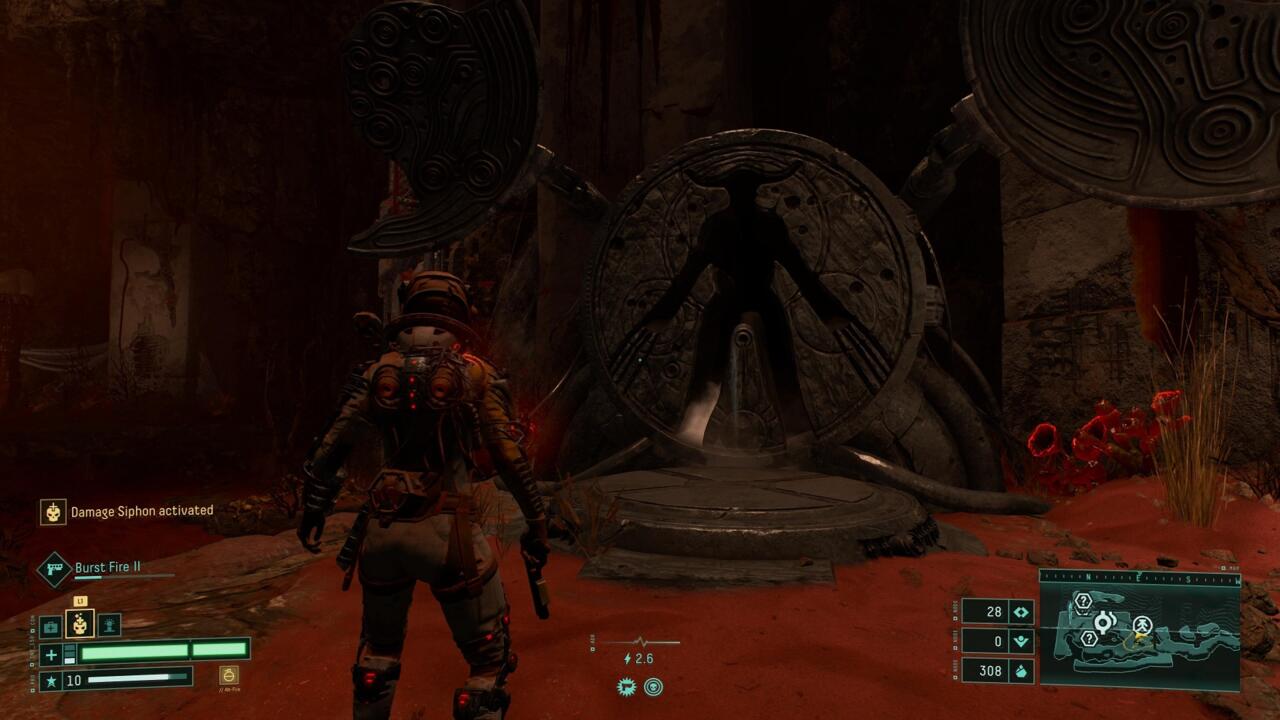
It also means you should be constantly aware of the Ether you're carrying and make sure to stockpile it accordingly. Every Reconstructor takes six Ether to power, and there's one in each biome, but a Reconstructor you powered in the Crimson Wastes won't save you if you die in the Derelict Citadel. That means you shouldn't spend Ether on Reconstructors in biomes you're just passing through or feel pretty comfortable in, and save it for when you're fighting bosses or exploring new territory. You should also forego using Ether to clear malignancy on items unless you've got some to spare. Ether is a precious resource specifically because you can use it to save your life, so keep Reconstructors in mind as you're making decisions about what items to pick up.
Save Up For Extra Life Artifacts
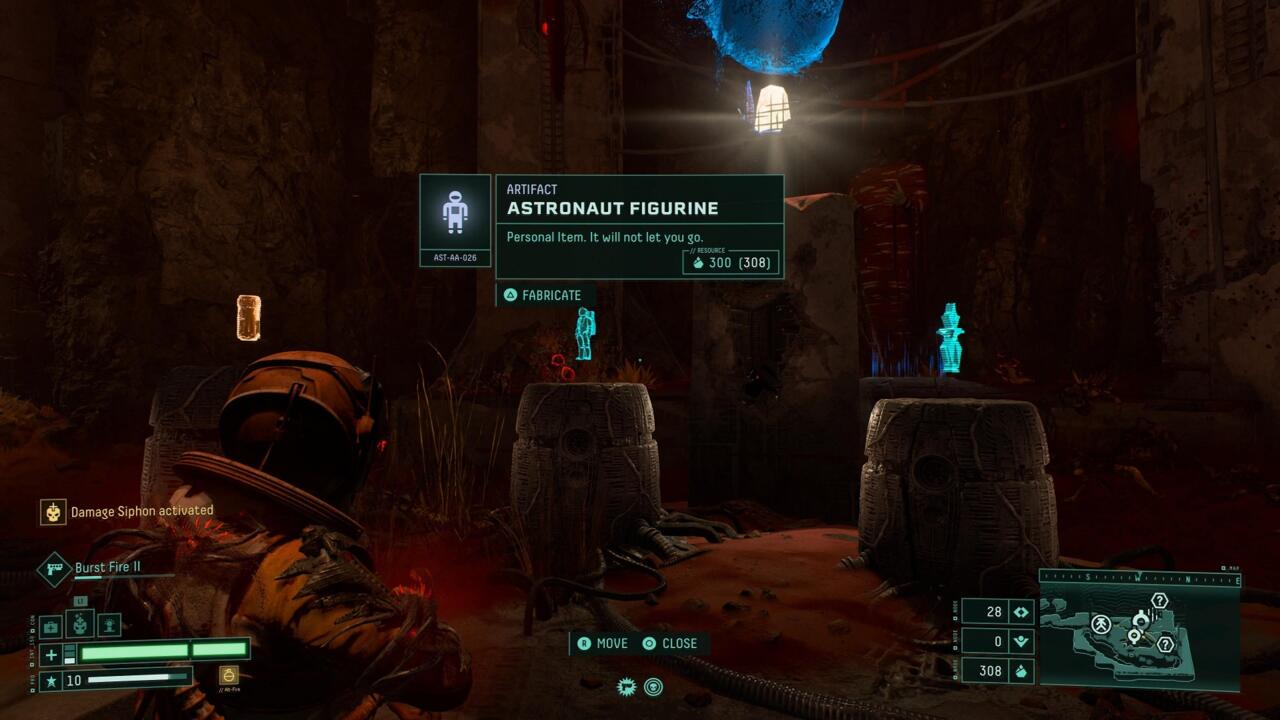
A few artifacts you can get from fabricator machines should never be passed up. These are the Astronaut figurine and the Child's Watch, once you've unlocked them. Their uses aren't immediately obvious from their descriptions, but if they're available, save up and snag them--they'll usually run you 300 Obolites. Like Reconstructors, these artifacts can save your life. Both the Astronaut and the Child's Watch will revive you if you die, but unlike the Reconstructors, they won't cause you to reawaken somewhere else--they'll bring you back to life on the very spot where you fell roughly two seconds later. That means if you've got an Astronaut figurine in your pocket when you fall fighting a boss, you get a second chance at it, waking up suddenly with full health. These two artifacts are essentially extra lives, so buy them when you see them. If you can't afford them when you locate them, come back later with more Obolites. It's always worth it.
Opt For Emergency Repairs
One more artifact you should always snag if you can: Emergency Repairs. Along with an Astronaut figurine, this one upgrade allowed me to complete the first three biomes in Returnal, plus their bosses, on my first run. It automatically repairs your suit up to 30% of your total Integrity if you're critically damaged--basically, it always keeps you from being one hit from death. That extra padding will save you time and again, specifically in boss fights. Emergency Repairs might be the best artifact in Returnal for keeping alive and going on long runs, so if you can get it, you absolutely should. Save your Obolites, as it's an expensive one, but if it pops up in a fabricator, make sure to come back for it.
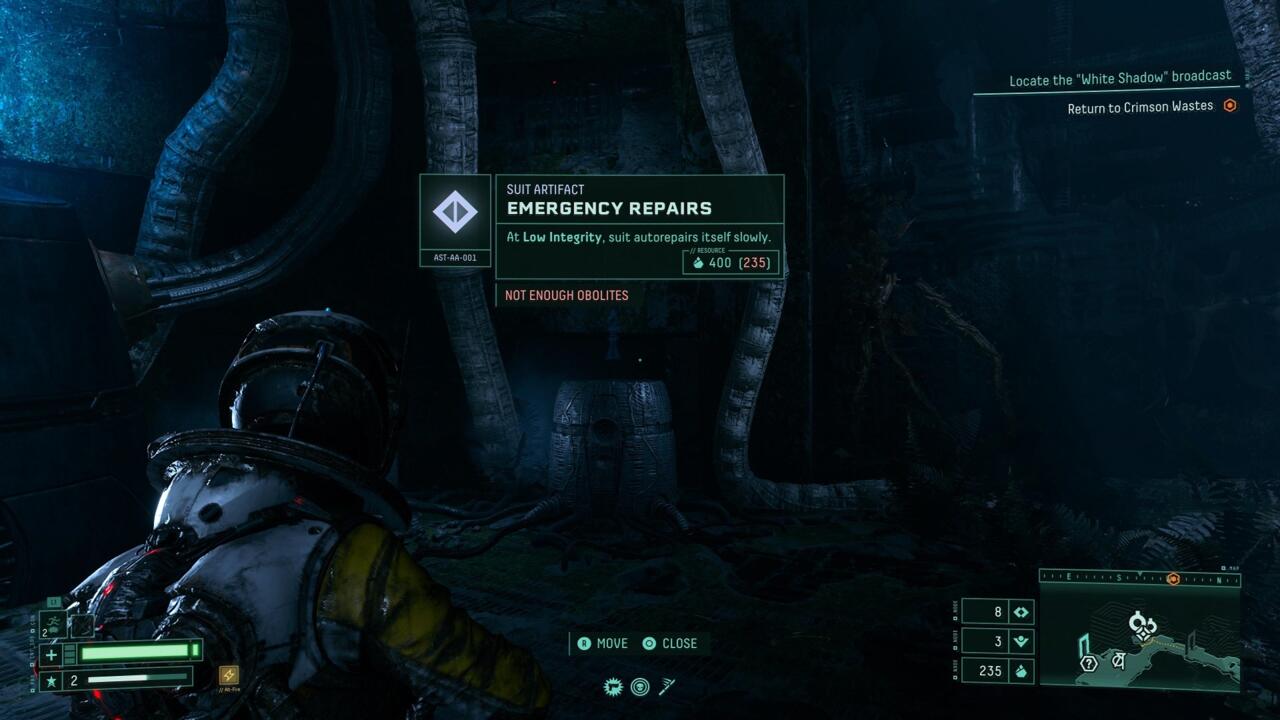
Emergency Repairs takes a few seconds to execute, so keep that in mind--it doesn't heal you instantly like picking up Silphium, it heals you slowly over time. That means you'll still die if you take two hits right in a row while you're at critical damage. But if you can keep moving and get to safety, Emergency Repairs is like always having a hit of Silphium in your back pocket.
We should note also that you can find this same perk from some parasites. It's almost always worth the tradeoff to have Emergency Repairs, unless it means drastically reducing your Protection or rendering repairs less efficient. Otherwise, if you can get this perk, you should.
Keep Track Of Data Cube Station Locations
As you explore biomes and after you beat your first boss, you'll likely run across Data Cubes. These are objects that aren't immediately useful to Selene in a fight, but which can unlock new items and add them to your overall item pool once you've found them. Put another way--you can't get certain items and artifacts until you've found their corresponding Data Cube, but once you've got it, those items can randomly appear at fabricators or in chests throughout the world. You have to unlock them to make them available for future runs.
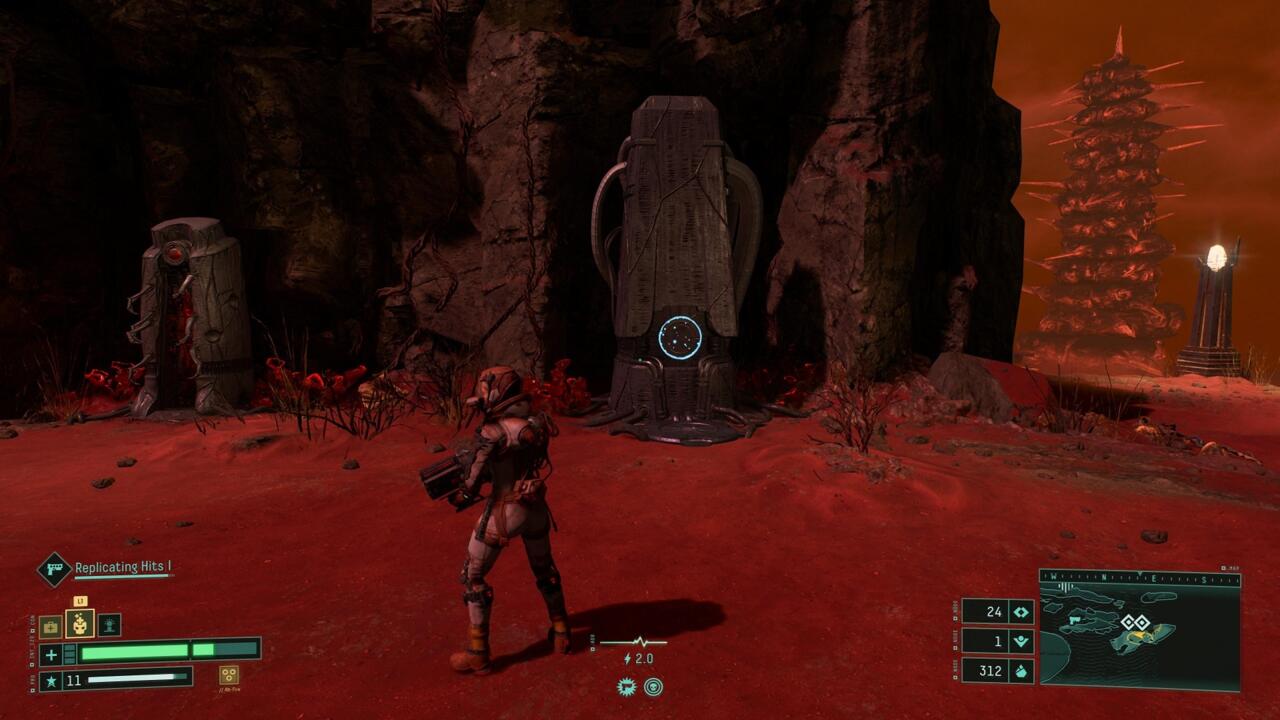
Data Cubes have to be inserted in particular devices, however. The good news is that these devices are always located in the same places in a biome, so when you run across one, you should memorize where you found it. Some stations are easier to come by than others--a few are right at the end of the biome or even past the boss, while others can be situated at central hub rooms or right at the start. But if you find a Data Cube while exploring, you should prioritize taking it to the device and getting it decrypted, because that new item might be a serious boon to you in the future. Knowing where you have to go can make that process a lot easier, especially as you get deeper into Returnal.
For more about Returnal, be sure to read our full review. Also, be sure to read our feature discussing why it's okay to constantly die in Returnal.
Got a news tip or want to contact us directly? Email news@gamespot.com
Join the conversation